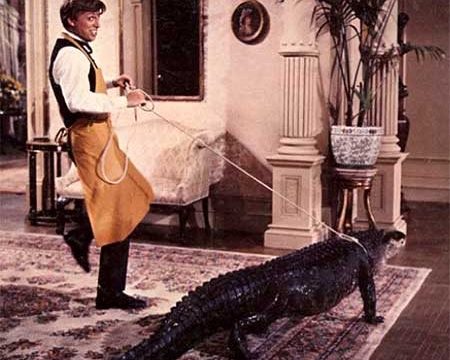Even my Disney defensiveness has its limits. While I do legitimately believe Walt Disney Studios to have had the best record of hits to misses for literally decades, that is not to say I don’t believe there were any misses. Most of those are minor; no one was expecting The Million Dollar Duck to be the blockbuster hit of the year or to win any Oscars, I’m sure. Even Dean Jones had to know that this was going to be a low point in his career, though I don’t think any of us could have expected that Gene Siskel would literally walk out of it. However, the success of Mary Poppins is apparent in every sinew of The Happiest Millionaire, and good Lord but it’s no Mary Poppins.
Based on My Philadelphia Father, by Cordelia Drexel Biddle, The Happiest Millionaire starts with happy-go-lucky Irishman John Lawless (Tommy Steele of London) getting hired as butler to the eccentric Anthony J. Drexel Biddle (Fred MacMurray). Biddle has a Bible academy/boxing school, as you do, and pet alligators, as you do, and two sons who disappear to boarding school early in the picture, as you do. And, of course, a lovely daughter, Cordelia (Leslie Ann Warren), who we know won’t disappear because she’s both the ingenue and based on the woman who wrote the book.
However, Cordelia, or Cordy as they call her, does go off to boarding school as well, because she’s been educated by private tutors and wants to see more of the world and perhaps attract a man. Which she does—specifically Angier Buchanan Duke (John Davidson), who goes by Angie. The two fall in love, despite their families’ immediate hatred of one another. Angie has dreams about going off to Detroit and making his own way; his family expects him instead to go into the family business.
It’s frankly hard to imagine who this movie was for. The short version is nearly two hours long; the unabridged is about three-quarters of an hour longer. It’s a movie whose title character is trying to get the US involved in World War I released during the Vietnam War. It’s a movie that relies on conflict between Old Money and New Money released during the War on Poverty. The Duke family is that Duke family, the tobacco family, and this became the last musical Walt was involved in before his death from smoking-related causes and several years after the release of Smoking and Health: Report of the Advisory Committee to the Surgeon General of the United States. The family business is tobacco.
Also ye Gods but it’s dull. It shouldn’t be—there are alligators in the conservatory, for pity’s sake—but it is. It’s the Disney movie people are thinking about when they think of bad big-budget Disney movies. The costuming budget was enormous, a half-million dollars out of the five and a half the film eventually cost. I mean, the budget is there onscreen, but it definitely proves there’s more to a film than its budget. The original producer was reassigned by Walt to the much lower budget Blackbeard’s Ghost—which ended up outgrossing it. For good reason, being lighter and more entertaining.
Oh, I like the songs okay. It’s Sherman Brothers, after all. Not their best work by any stretch, but a middling Sherman Brothers song is still better than the best work by some other songwriters. Not songs I find myself thinking about very often, but “Fortuosity” is fun, and “Let’s Have a Drink on It” as well. It’s hard to find yourself getting as excited about Detroit as John Davidson, but that’s often the case for the object of passion for movie characters, and you just kind of roll with it.
A bigger problem for me, honestly, is how hard it is to get worked up about John Davidson. Leslie Ann Warren is in her first real feature film role here—she had one uncredited movie before—and she’s delightful as always. But John Davidson, frankly, always did seem destined to be a game show host. It’s hard to think of Angie as wanting to be Henry Ford when you’re picturing him as more Merv Griffin. And that’s even before you get into things like “the real Angier Buchanan Duke was ten years older than Cordelia Drexel Biddle and a career diplomat and missing a hand and part of his arm.” Nothing personal against John Davidson; he’s just not the heartthrob type.
Tommy Steele, meanwhile, was apparently a manufactured star of the early ’60s. He was charming and personable, your standard little Cockney sparrow type with a for-the-role Irish accent. The movie has far too many plots going at once and would be best served by cutting at least one—I suggest “let’s get into World War I,” for starters—but John as our introduction to the family is probably the film’s best part.
With a little work, you can take the core of the movie and make something light and fun, but honestly, the cutting needed to start far in advance of its Radio City Music Hall debut. It needed to have at least one, and probably several, more script drafts first. It needed to figure out where the story was going and just go there, without a whole lot of sidetracks about the five or six other running plots. You could probably get a solid two-hour movie out of this with a couple of good rewrites and at least one casting change; this, to me, is a much better candidate for a remake than Disney’s actual successes.
Since Disney won’t pay me for these ideas, you might as well; consider supporting my Patreon or Ko-fi!

